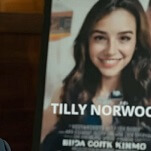Each week, Big Issues focuses on newly released comic books of significance. This week, they are Batgirl #35, written by Brenden Fletcher and Cameron Stewart with art by Stewart, Babs Tarr, and Maris Wicks, and Sabrina #1, written by Roberto Aguirre-Sacasa with art by Robert Hack. These two issues update classic female characters to give them broader appeal, making bold stylistic choices that considerably elevate the stories. (Note: This review reveals major plot points.)
Barbara “Batgirl” Gordon and Sabrina The Teenage Witch have been regular comic-book fixtures since the 1960s, so it’s understandable that they would get a bit stale over time. Taking Barbara Gordon out of a wheelchair and putting her back into her old Batgirl costume for the New 52 reboot was a step backward for a character that had forged a new identity with its own unique responsibilities, and while Archie has tried to keep Sabrina fresh—notably with a manga-inspired run in the mid-’00s by Tania Del Rio—those changes have primarily been cosmetic.
These two characters have proven their popularity by withstanding the test of time; they just need the right creative teams to bring out the qualities that made them stand out in the first place. Barbara Gordon was introduced in Detective Comics because the producers of the 1960s Batman TV series wanted to debut a character that would attract a female audience, and the new creative team on Batgirl makes an aggressive play for that same target group by focusing on how Barbara’s experience isn’t all that different from that of any other female college student in her 20s. Sabrina’s connection to the supernatural world differentiated her from the rest of Archie’s teen characters, and the new Sabrina series embraces the character’s mystical roots to put her in a horror story heavily influenced by EC Comics.
In the case of Batgirl, the incoming creative team is trying to make the title and the character as modern as possible, relocating Barbara to Gotham’s hip Burnside neighborhood and giving her a diverse new supporting cast along with a sleek, stylish costume redesign. Writers Brenden Fletcher and Cameron Stewart do exceptional work grounding Barbara’s experience in reality, taking ample time at the start of the story to establish the character’s current domestic situation. Before Barbara gets in costume, the reader gets to know Barbara’s new friends, home, and neighborhood, and defining those elements of her personal life pulls the audience deeper into Barbara’s perspective.
The reality of Barbara’s situation is further established by the detail in the linework by Stewart (breakdowns) and Babs Tarr (finishes), taking advantage of Burnside’s status as a “cool” neighborhood to create an environment that is a dramatic shift from the rest of Gotham. Fashion plays a big role in that respect, and the art team fills the setting with characters that look like the people walking the streets of modern-day Brooklyn. A two-page spread of Barbara Gordon accessing her computer-like memory to retrace her steps through the previous evening’s party is the perfect example of how this book’s art team (including colorist Maris Wicks) brings the characters and the setting to life, showing a wide variety of distinct characters and giving readers a clear layout of the environment where Barbara will be spending most of her time.
With a plot involving a technologically gifted villain that uses social media to expand an empire built on invading the privacy of others, Batgirl #35 definitely feels like a product of the times. In a scene where Barbara is set up with a new Hooq profile by her new roommate Frankie, the script draws a comparison between the mask Barbara wears as Batgirl and the mask society often expects women to put on to be more attractive to men, and after dolling herself up and dumbing herself down for her profile, Barbara immediately gets to work on bringing back the mask that gives her power.
(In a quick bit of exposition courtesy of guest star Dinah “Black Canary” Lance, it is revealed that all of Barbara’s old Batgirl gear was destroyed when Dinah’s storage unit caught fire. Hopefully the presence of Dinah in this first issue means she’ll be a regular part of the supporting cast, because the New 52 has not been kind to her character.)
Batgirl #35 lands just a few weeks after Marvel made waves with its own dramatic new take on a classic female character, introducing Gwen “Spider-Woman” Stacy in the pages of Edge Of Spider-Verse #2 by writer Jason Latour, artist Robbi Rodriguez, and colorist Rico Renzi. Coincidentally, there are a lot of similarities between Spider-Gwen and the Batgirl of Burnside: They’re both college students that moonlight as urban vigilantes, and they both have cop fathers. They both wear exquisitely designed superhero costumes that are extremely cosplay friendly, and their stories are realized with a clean, animated visual style that emphasizes the fun side of superheroics.
Despite the similarities, these two characters aren’t treading the same ground. Gwen Stacy and Barbara Gordon are two very different characters with very different motivations, and the work done by the creative teams of their respective comics sets them apart by delving deep into their individual personalities. That focus on character development is more important than the slick redesigns and the bold new status quos, and both Batgirl #35 and Edge Of Spider-Verse #2 captivate readers by telling a standalone story that establishes who each heroine is, what she wants, and what she’s willing to do to get it.
The new team on Batgirl is focused on bringing contemporary style to the title, but Sabrina moves in the opposite direction to reinvigorate the property. After successfully incorporating Archie’s bright characters into a grim, grotesque horror story in the page of Afterlife With Archie, writer Roberto Aguirre-Sacasa continues to explore that fascinating contrast of light and dark elements in Sabrina, this time in a period piece set during the 1950s and ’60s.
Sabrina isn’t set in the same continuity as Afterlife With Archie, giving Aguirre-Sacasa and artist Robert Hack the opportunity to create their version of the character from scratch. Taking heavy inspiration from the horror stories of EC Comics, the new series gives the teenage witch a tragic origin story, one that sees Sabrina’s human mother driven insane by her evil warlock father, who eventually leaves the girl an orphan when he’s doomed to his own terrible fate. The supporting cast remains the same—aunts Hilda and Zelda, talking cat Salem, and high school heartthrob Harvey Kinkle are all here, and Sabrina’s mischievous hipster cousin Ambrose makes his return to comics after toiling in limbo for the past few decades—but the world they live in has changed dramatically.
The first issue of Sabrina includes a reprint of her first appearance in 1962’s Archie’s Madhouse #22, and putting classic Sabrina side-by-side with the updated version of the character shows just how huge the tonal shift of this new series is. The cartoonish visuals of Sabrina’s past are replaced with a more textured, atmospheric art style that brings a hefty amount of realism to the story, and Hack’s muted color palette sets a bleak mood that is a sharp contrast to the cheerful brightness of Sabrina’s first appearance. Like Afterlife With Archie, this book is not appropriate for all-ages (neither is Batgirl, for that matter), but embracing a more mature point of view enlightens a different side of the character that isn’t explored in the regular Archie universe.
While the aesthetic gets a drastic overhaul, the script by Aguirre-Sacasa still explores the key ideas that have defined Sabrina’s experience: the conflict between her witch half and her human half, the consequences of using magic for personal gain, and the unfortunate reality that being a witch doesn’t make being a teenager that much easier. In both Sabrina #1 and Batgirl #35, the creative teams don’t lose sight of the qualities that have made these women classic comic-book characters. Instead, they find new ways to give those classic elements new relevance for contemporary audiences, making Barbara Gordon and Sabrina two long-standing characters that suddenly have a lot more future promise.






































